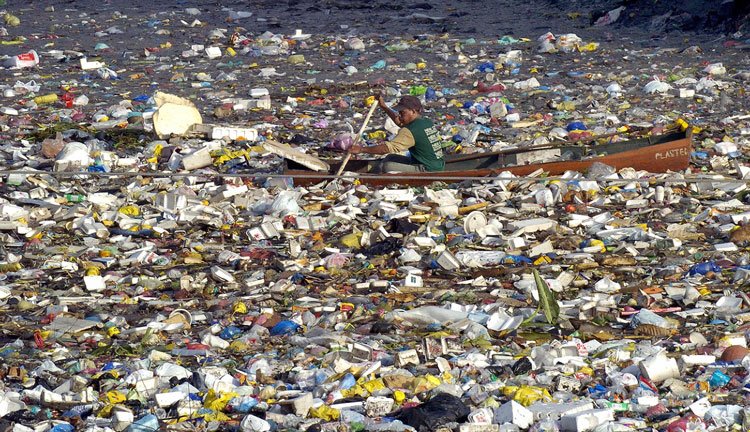
Imagine yourself independently wealthy. You buy yourself a yacht. You love the open seas. You become passionate about sailing and your life revolves around planning trips to exotic places.
Then something happens that changes your world.
Such is the story of Charles Moore, heir to an oil fortune, now environmental activist and founder of the Algalita Marine Research Foundation.
After designing his own unique racing yacht, Moore entered a Los Angeles to Hawaii race. It was 1997. Upon sailing home he willfully entered a part of the Pacific Ocean as a shortcut home, an area that is usually avoided by sailors and fishermen: an area of weak winds and weak currents and little fish that is the eye of a circle of currents thousands of miles wide called the North Pacific Gyre.
What he stumbled upon changed his life.
A sea–as far as the eye could see–of plastic debris–yellow Chevron oil bottles, tampon applicators, plastic bags, old fishing lines, shampoo bottles and Japanese traffic cones. He traveled for days through discarded plastics, miles after mile after mile.
I can only imagine his disbelief, his shock. When I first read about his experience, I too was shocked and wrote about it here. The ocean that he sailed because it was endless and pristine, was much like the wilderness that avid backpackers venture into to escape civilization –only to find the its ugliest remnants–trash.
In Moore’s words:
I often struggle to find words that will communicate the vastness of the Pacific Ocean to people who have never been to sea. Day after day, Alguita was the only vehicle on a highway without landmarks, stretching from horizon to horizon. Yet as I gazed from the deck at the surface of what ought to have been a pristine ocean, I was confronted, as far as the eye could see, with the sight of plastic.
Not a scientist himself, but with conviction and money, Moore founded the Algalita Marine Research Foundation in 1999 and built a network of chemists and scientists. He enjoined Curtis Ebbesmeyer, an oceanographer and leading authority on flotsam, who famously tracked the spill of 80,000 Nike running shoes on their way from China to the US. (the resultant wash-up on beaches throughout the Pacific allowed him to track and identify the behavior of currents).
Since this initial discovery and the funding of the Foundation, Moore has underwritten several trips to the area for further research. In 2001, according to the Marine Pollution Bulletin, they published that there were six pounds of plastic floating in the North Pacific subtropical gyre for every pound of naturally occurring zooplankton.
Most recently, after another exploration and research trip to the region, Moore acknowledges that the results are beyond imagination: the plastic soup he encounters is now–not the size of Texas as was noted in 1997. Not the size of the United States as noted in 2001. Now it is estimated, when one takes into account the “eastern” and “western” patches, to be double the size of the continental US.”
There are those who dispute his figures and Moore acknowledges that it is difficult to document the phenomenon. Satellite imagery is not able to pick up the plastic because it floats slightly below the surface and is largely translucent.
The “soup” is actually two linked areas, either side of the islands of Hawaii, known as the Western and Eastern Pacific Garbage Patches. According to a study released by Greenpeace, about one-fifth of the junk – which includes everything from footballs and kayaks to Lego blocks and carrier bags – is thrown off ships or oil platforms. The rest comes from land.
Ebbesmeyer, as “flotsam expert” portrays the North Pacific plastic trash cluster vortex as a living entity:
“It moves around like a big animal without a leash.” When that animal comes close to land, as it does at the Hawaiian archipelago, the results are dramatic. “The garbage patch barfs, and you get a beach covered with this confetti of plastic,” he added.
All this plastic breaks down but never goes away. Sunlight breaks the plastic into smaller and smaller bits, all ingested gradually into the food chain. Birds dive for the brightly colored plastic and sea turtles chase plastic bags like jellyfish.
“What goes into the ocean goes into these animals and onto your dinner plate. It’s that simple,” said Dr Marcus Eriksen, director of research and education.
This is our petroleum, our drilled and pumped oil, our endless ingenuity, reconfigured into new matter; matter causing serious consequences for our living on the planet.
The annual production of plastic resin in the United States has roughly doubled in the past 20 years, from nearly 60 billion pounds in 1987 to an estimated 120 billion pounds in 2007, according to a study by the American Chemistry Council, which represents the nation’s largest plastic and chemical manufacturers.
So plastic is not going to go away. We can’t even do a massive cleanup operation to stop the damage. But we must start being aware of what we are doing. Remember that lovely video of the floating plastic bag in the movie “American Beauty”? Now picture that bag escaping the little whirlwind it was in as it begins its journey down the storm drain and out to sea.
“Oil is the raw material for most plastics manufacturing; oil was also the source of Moore’s inherited fortune.
“In a way, part of all this is remediation for the consequences of my grandfather’s life,” Moore says. “I guess maybe I need to make amends.”

O! Horrifying and disgusting! Two times the size of the U.S.???
Excellent writing, Bonnie. You are such a good reporter. Your distinct voice comes through but never intrudes on the issue, just humanizes it.
What can we do?!
What must we do?!
love,
mickey
Bonnine, how may I share this wonderful information with friends who
are passionate about these matters?
Love,
Ann